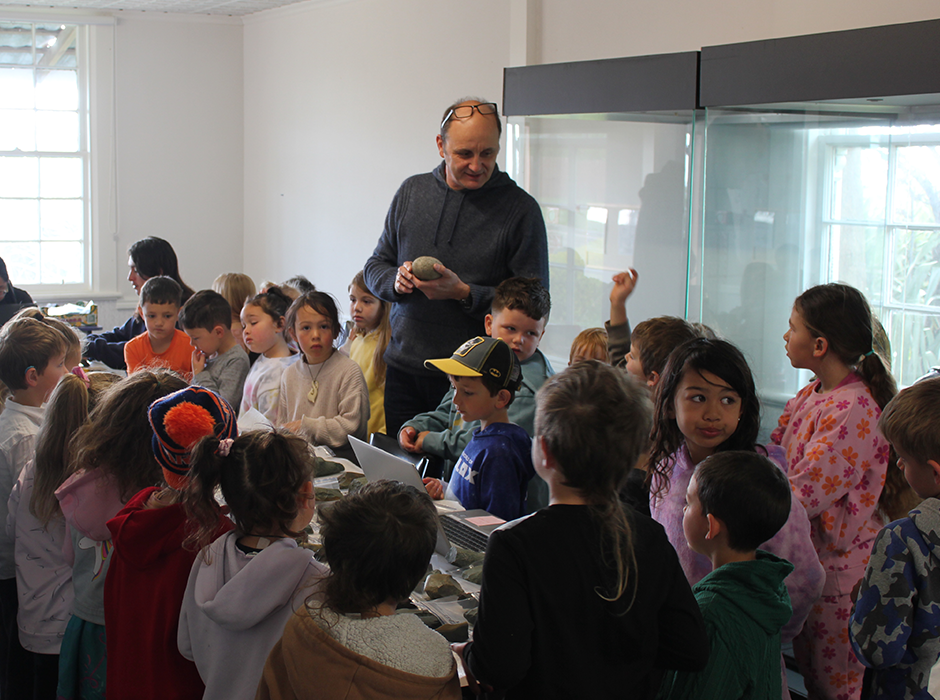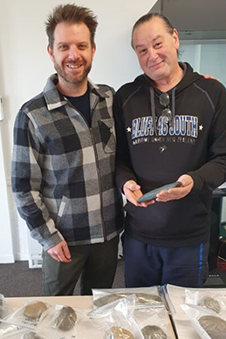
Dr Gerard O’Regan (Curator Māori, Tūhura Otago Museum) explains to Bluff School tamariki how the stones were shaped by the tupuna.
One keen-eyed beach walker’s finds have inspired a successful community-based initiative to identify and register taoka tūturu in Southland.
Aaron Fowler has been finding these precious stone artefacts created by some of the earliest Māori settlers on his local Bluff beaches over a few years. Keen to see them find their way to the right place, he sought advice from Te Rūnaka o Awarua at Te Rau Aroha Marae in Bluff.
Dr Gerard O’Regan (Kāi Tahu), Tūhura Otago Museum Curator, was visiting the marae on another kaupapa, so Fowler brought some of the collection of taoka (treasures) around to show him.
“When we saw how much there was – a couple of weeks’ of analysis work for someone tucked away in the basement at the museum – we thought ‘wouldn’t it be lovely if we could do it on the marae, where people could come in and see what is going on, learn about these objects, and do a bit of a promotion that they are meant to be reported?’,” says Dr O’Regan.
“Increasingly we are trying to keep taoka where they are found, and there’s strong recognition in the wider community about keeping things local. So, keeping it in the area and on the marae was really important.”
With support from the Southern Regional Heritage Fund, Te Rūnaka o Awarua brought together archaeologists and curators at Te Rau Aroha marae for a locally styled ‘antiques roadshow’. The team were from Tūhura Otago Museum, Southland Museum & Art Gallery, and Southern Pacific Archaeological Research (SPAR) at the University of Otago.
For five days in October, the public were welcomed along to see the collection and the team at work.
The public response to the invitation was beyond the team’s expectations, with over 200 people including local school groups and people from across the region joining them.
“Everybody who came in gave their time to the kaupapa. We had people travelling to Bluff for this from around Southland, being so willing to engage,” says Dr O’Regan.
Many people don’t realise that taoka tūturu are meant to be registered with The Ministry of Culture and Heritage, under the Protected Objects Act.
Dr O’Regan explains that there is a misconception of a ‘finders keepers’ rule, when actually: “These taoka tūturu are of the time of our tūpuna (ancestors), so still belong to our tūpuna. We have a kaitiaki (guardianship) role, rather than ownership.”
An important part of the registration is identifiying taoka tūturu and describing them accurately.

Dr Chris Jennings (Southern Pacific Archaeological Research) with Aaron Fowler, with some of the large collection of taoka tūturu Fowler has collected from Bluff beaches.
This mahi was led by Dr O’Regan, who is also a Honorary Research Fellow in the University’s Archaeology Programme, and Dr Chris Jennings, Senior Archaeologist at SPAR, which carries out archaeological research in New Zealand and the Pacific, and provides a range of specialist archaeological, heritage and laboratory consultancy and analysis services.
Dr Jennings was particularly qualified for this role as his PhD studies were on the stone tools of Murihiku (Southland).
The team at the marae began with identifying and registering Aaron Fowler’s finds; a collection of over 270 taoka.
“Aaron has a remarkable ability to identify these items as taoka,” says Dr Jennings. ”Many people would just walk past them, thinking they were rocks.”
During the five days, another person from Bluff came in with a comparable collection he had found along the coast, another brought in taoka from a historical collection found on her family’s farm, and more artefacts came in with other retired farmers from central Southland.
“Most people aren’t aware of the detailed story we can read from the stone and design, so it was lovely to help them with that,” says Dr Jennings.
He says it was also a wonderful opportunity to get a lens over the whole collection, and learn from that.
“Everywhere these taoka have been found is an archaeological site that is deteriorating or destroyed as a result of coastal erosion. So this is helping build our understanding and picture of those places.
“This was a valuable experience on so many fronts - archaeological research, supporting an iwi in their objectives, community objectives, public outreach, having time to have all these conversations, and so many learning opportunities.”
Dr Jennings says it was important to the team to make people feel comfortable to come along and share.
“There’s no negative judgment in having these objects if you don’t know what to do with them. Often people are unsure of its future management, and most are wanting it to end up where it should be. In our work we can help find that pathway.”
If you do have an object you think may be taoka tūturu please contact your local museum, or Otago’s Mātai Whaipara Takata Archaeology department to help get it identified and registered.
Read more about Southern Pacific Archaeological Research.